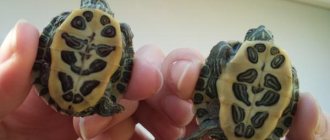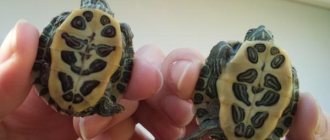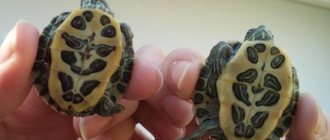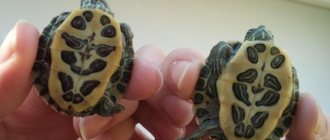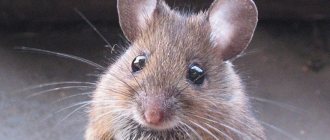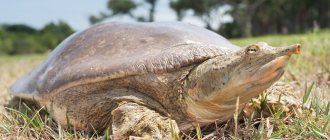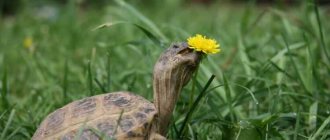What do turtles eat in the wild?
The main component of the diet of red-eared turtles in the wild are shellfish: mussels and snails, oysters, and crustaceans. They have no teeth, but this does not prevent them from excellently dealing with mollusk shells: with strong jaws they break them and eat the pulp.
In the summer, insects become food for turtles: grasshoppers, beetles, etc.
They are very fond of algae, plankton and small fish. They also eat tadpoles, fish fry and frogs.
Reproduction
Turtles reach sexual maturity in nature at 6-8 years of age. In captivity, they grow faster, and sexual maturity occurs earlier: in males by four years, in females by six years.
Preparation for the mating season begins in winter. For turtles, the lighting time is reduced to 6 hours and the water temperature is lowered by 2-3 degrees. This is enough for the turtle to think that winter has come, but not to fall asleep.
In February, the temperature is gradually increased and daylight hours are increased to 10-12 hours. At the same time, turtles believe that spring has come and the time has come for mating games and courtship. For successful reproduction, turtles are fed with vitamins.
Turtles of different sexes are placed in the same aquarium and their behavior is monitored. When the male begins mating games, the female either responds to them or shows aggression. In case of aggression, you should place the turtles for a few days and then try again. If mating is successful, you need to prepare a place for laying eggs.
The turtle requires a piece of land with soil (for example, a container with sand), where it digs a hole, lays 5-20 eggs and carefully buries it. Next, the clutch can be fenced off in an aquarium or the eggs can be removed and placed in an incubator. The incubation time of eggs depends on the ambient temperature.
At a temperature of about 30 degrees, the turtles will hatch in 60 days; if the temperature is lower, the incubation period can increase to 150 days. Newly hatched turtles should be kept separate from others. Turtles lack maternal instinct and can injure babies.
Caring for and maintaining turtles is not a very difficult task. Under good conditions, they can mate and lay eggs up to 5 times a year. With proper care, a red-eared turtle can live up to 40 years and delight its owner with its impressive size.
Diet of the red-eared slider
A necessary aspect of caring for turtles is preparing the right diet. The health of your pet depends on feeding high-quality, fresh and, importantly, varied food. How the red-eared turtle feeds, how long it lives, and how it feels are closely interconnected.
In captivity, this reptile has little demand for food. For a tough shell and healthy skin, reptiles require both plant and animal products. For turtles up to one year old, the latter must be included in the diet in an amount of 80% or more.
A reptile's hard shell requires plant and animal products.
Mature turtles need to increase the amount of plant foods rich in fiber and vitamins. As a result of eating only meat, pets can develop rickets, hypovitaminosis or obesity.
The required vitamins and dietary supplements must be regularly added to food.
Recommendations for how many times per day to feed your red-eared slider will depend on the age and preferences of the individual reptile.
If the turtle is up to 1-1.5 years old, there should be one or two meals a day. If you have no appetite, reduce the amount of food or go on a short hunger strike for 1-2 days.
To create an optimal nutritional regimen for an adult, you should observe the pet and feed it on demand. If a turtle is hungry, it becomes overly active in the presence of its owner, hitting the water with its paws. After feeding, she calms down and rests calmly. A turtle may require food daily, or maybe once every 7 days.
Heater and filter
Choose these devices based on the volume of water in the aquarium. There are many filter options, some of which allow you to change the water once a month. External filters require less maintenance, and there is no chance that your reptile will remove it from the wall, swallow the suction cup or bite the electrical wire. As for the heater, you need one that can automatically regulate the water temperature within a specified range. A comfortable temperature for a turtle is 20-27 °C.
Basic feeding rules
To properly feed a red-eared turtle, you must comply with the basic conditions and some subtleties:
- Any food needs to be cut into pieces: the smaller the turtle, the smaller the pieces.
Any food needs to be cut into pieces
- Aquatic reptiles tear large pieces with their sharp claws, so that plant food can be fed whole.
- Before serving, products must be washed, seeds and peels removed.
- The pet should eat the food within 30 minutes. The serving size should be calculated based on this indicator, and should not exceed half the size of the shell. You can also give pieces of food the size of the reptile's head.
- Feed should be given at room temperature. Very cold food is harmful to your pet's health.
- Turtles search for food using their vision. The more attractive the color of the food, the faster she will find and eat it. For this you can use carrots and tomatoes.
- It is better to feed your pet in the morning, but it is not essential. It is important that she has time to digest what she eats during daylight hours or with the lamp on.
- Uneaten food must be immediately removed from the reservoir - this way the reptile will develop the habit of eating at certain hours.
There are different ways to feed armored animals: with tweezers, from a special bowl, or by throwing them into water.
You can feed red-eared turtles with tweezers
It is best to feed the red ear in another aquarium or basin, because leftover food will contaminate the terrarium, and the water will have to be replaced frequently.
You can also teach him to eat on an island equipped in the aquarium. First, food is placed at the very edge of the shore near the water. If the reptile is hungry, it will have to take food. So gradually get used to eating from a small saucer with water.
You should not hand feed your reptile too often to avoid getting used to this method of feeding and refusing to eat differently. There is also a risk of being bitten.
You cannot distract your pet while eating: sudden movements and loud sounds frighten him.
Aquarium
Ideally, 150 or more liters, but for starters, 10 liters will be enough. However, prepare for the fact that your pet will grow quickly, gaining 3-4 cm in height every year until it reaches its normal size (20-30 cm depending on gender and subspecies). They also need to exercise a lot to avoid becoming obese. Yes, turtles can also suffer from this disease. Therefore, the minimum dimensions of the aquarium should be such that its width is not less than three shell lengths, and its length is not less than six lengths.
You need to pour enough water so that the turtle can stick out its muzzle while standing on its hind legs. If the aquarium is deeper, then you can place a stone or driftwood in it for this purpose.
It is strictly forbidden to use small stones as soil! Being carried away by getting food, small turtles (and sometimes adults) can accidentally swallow a pebble, which will cause intestinal obstruction and, as a result, the death of the animal. Remember that some aquatic plants (Elodea, Lagenandra, Ambulia) are poisonous to reptiles.
What can you feed your red-eared slider?
At home, you can use special food purchased at a pet store to feed your red-eared reptile. If your pet shows signs of illness, for example, a red-eared slider's shell is peeling off, you should pay attention to the quality of its diet.
For the main diet, meat and offal, cottage cheese and eggs are used, as well as fish, seafood and insects. The use of various types of plants, vitamin and mineral supplements is recommended.
Animal feed
This food serves as the basis for the diet of aquatic turtles. For a growing animal, the portion size and variety of food should be increased.
Red-eared turtles prefer live food: snails, small fish, insects and crustaceans. Such nutritional components will be good for diversifying your diet, but you shouldn’t get too carried away with them. It is enough to apply them 2 times a month.
Red-eared turtles prefer live food, but you shouldn’t get carried away with it
Food can be served either raw or cooked, unsalted and unseasoned, divided into pieces.
Meat
The red-eared slider's diet may include lean beef, horse meat, rabbit, chicken and turkey.
Reptiles also eat minced meat. Finely chopped plant food is added there if the turtle refuses it.
By-products
By-products should be added systematically to the red ear's diet. From a wide variety, you should choose only beef or poultry liver and heart. They contain a significant amount of vitamin A, which helps normalize the growth of the pet and maintain healthy skin. Due to a deficiency of this vitamin, detachment of the horny scutes, development of conjunctivitis, etc. are possible.
By-products should be added to the diet systematically
It is recommended to give liver only to adult turtles once every 30 days.
Cottage cheese and eggs
It is difficult to feed cottage cheese to replenish calcium levels to a turtle - it disintegrates in water. But they like to catch it and eat it.
Eggs are used raw, mixed with various types of products.
Fish and seafood
Fish is recommended in raw low-fat varieties (up to 3.0%), such as hake, blue whiting, pollock and cod, and freshwater perch. River species are best suited.
Before feeding, you can remove large bones from the fish, but leave the giblets, because the turtle needs all the useful substances contained in the fish to maintain the rigidity of the shell and skeleton as a whole.
In order to eliminate the negative effects of thiaminase in raw fish, immediately before feeding, it is necessary to put it in hot water for 2 minutes.
Among marine products, green shrimp are used as food for reptiles; they enjoy octopus and squid, and eat mussels and snails.
Reptiles enjoy eating octopus, squid, and shrimp.
If there are fish or frogs living with the turtle, there is a high chance that it will eat them.
Insects
The menu of the red-eared turtle should include insects: beetles and hairless caterpillars. He loves to eat grasshoppers and crickets, earthworms, and also eats mealy bug larvae.
In summer they are collected in the garden and park. But you can’t collect it where it has been treated with chemicals.
Cockroaches caught at home should absolutely not be given in order to avoid insecticide poisoning.
Pet stores sell bloodworms and mealworms to feed armored reptiles.
It is recommended to purchase gammarus - small dried crustaceans. It contains a significant amount of calcium. Koretra and daphnia are also suitable food for your pet.
Insects are used as food for the turtle 1-2 times a week.
Fruits
All types of fruits contain many vitamins.
To the question whether a red-eared turtle can have an apple, there is one answer - you can also have a pear, a banana, an orange and a peach, or a plum and an apricot. Only citrus fruits should be peeled.
You can give your red-eared turtle apple, pear, banana and other fruits.
It is also recommended to occasionally give strawberries, wild strawberries, and pamper your pet with raspberries and other berries. The turtle can also have melon and watermelon.
Vegetables
Vegetables are rich in fiber, which is very beneficial for the gastrointestinal tract, and in particular, the process of food absorption, as well as vitamins A and K, calcium.
These reptiles eat cucumbers, zucchini, cabbage leaves, and red tomatoes, bright sweet peppers, pumpkins, carrots and beets attract their attention. You can even offer beans and asparagus.
They are given raw, without signs of spoilage and without mold. Cooked vegetables have no benefit for the turtle.
Mushrooms
Along with vegetable and fruit food, the red ear can be fed once every 7 days with mushrooms: slices of russula, champignons and boletus.
Greens and plants
These products are also important in the diet of turtles. They must consume them at least 50% of the total diet, and for older turtles this figure reaches 75%.
It is also recommended to feed these reptiles indoor plants, for example, thornless cacti and agave, tradescantia, hyacinth and hibiscus. It is very useful to feed with herbs from meadows, dandelion, coltsfoot, as well as plantain and clover. These reptiles have a good appetite for carrot and beet tops, lettuce leaves, basil and parsley, and dry hay. It is recommended to feed with sprouted wheat or oats (cut sprouts 5-10 cm).
These reptiles have a good appetite for carrot and beet tops
The greens are picked in the garden or in the forest far from roads, sorted and washed.
Aquatic plants, for example, duckweed, hornwort, pistia, water hyacinth, etc. are extremely useful for these reptiles.
It is better to breed them separately. After all, the algae growing in an aquarium with red ear is constantly plucked by it, which disrupts the landscape design. Having eaten algae, she may not accept other food.
Duckweed can be caught from a nearby pond.
Toxic algae (elodea and limnophila) are destructive to turtles.
Plant food
The diet of an adult turtle should be dominated by plant components . The older she is, the more vegetarian dishes are on the menu.
Grass
Little Reds eat their coltsfoot with gusto. Also great for:
- leaves of plantain, clover, dandelions;
- sprouted oats and barley.
Aquarium plants
Seaweed is a good addition to the menu. Duckweed, watercress and any plants from natural bodies of water are suitable
Vegetables
Turtles love kibble:
- bell peppers;
- zucchini;
- eggplant;
- cucumbers;
- tomatoes;
- carrots;
- beets;
- pumpkins.
Mushrooms
Once a week, champignons, russula or boletus , cut into small pieces, are added to the regular diet.
Artificial feed
Pet stores have a wide variety of balanced foods specifically for armored reptiles. They can come in various forms: capsules, tablets, granules and even flakes. And their compositions will vary. But for the most part, the food produced by the manufacturer often does not satisfy all the needs of the reptile’s body.
In essence, turtle food is food for aquarium fish that has been improved to meet the needs of the reptile's body. Due to the specific smell, pets may even ignore it, but over time they get used to it.
This type of feeding is convenient, but you cannot feed it alone
This type of feeding is convenient primarily for busy people, but it is not the only way to feed. Such feeds often do not maintain the balance recommended by veterinarians, which can lead to vitamin deficiency and digestive problems for the animal.
Mineral mixtures and vitamins
It is necessary to feed the aquatic turtle with vitamin and mineral mixtures. Active growth, healthy skin, and proper development of the skeleton and bone tissue depend on them.
Aquatic turtles receive useful substances not only from a variety of foods, but also from special supplements. The diet of such a pet should contain moderate amounts of vitamins A, B12, D3, E, as well as minerals such as selenium and calcium.
Regular feeding with calcium-containing preparations is especially important for turtles to strengthen their shells, especially in growing young individuals. With calcium deficiency, it can become crooked and lumpy. Claws may also become bent, limbs may occasionally break, and in extreme cases, the shell may even fall apart or become like cardboard. In nature, sources of calcium for turtles are limestone, oyster shells, corals, dolomites, and animal bones.
Calcium-rich foods include the popular gammarus. A significant amount of it is found in bone meal, ground egg shells, and also in feed chalk. They are given 100 mg of the mixture per 1 kg of pet’s weight once every 7 days.
The most applicable drugs are purchased at a veterinary pharmacy or pet store.
Feed containing vitamins and minerals (except calcium) cannot be stored for a long time. Vitamins for the prevention of vitamin deficiency C and E and mineral supplements are given only once a month, mixed into the food.
Vitamins and mineral supplements are given only once a month, mixed into the food
To ensure that the turtle consumes all the added nutrients, you should mix them with food and feed them by hand.
Ready-made food in a pet store
Dry food for red-eared turtles can be used only in cases where it is not possible to maintain a balanced diet using natural products.
Although manufacturers promise to fully satisfy the reptile’s needs for the necessary substances, they do not recommend making semi-finished products a monotypic type of food in order to avoid metabolic disorders and problems in the gastrointestinal tract.
Food for cats and dogs
It is not recommended to use either dry or wet dog or cat food for feeding red-eared turtles.
This combination food is specially developed in the optimal ratio for feeding warm-blooded animals, so it is not suitable for reptiles. It contains a set of substances that are absolutely useless for turtles.
Vitamin and mineral supplements for these pets also do not meet the needs of the turtle’s body.
Homemade food for red-eared turtles
It is possible to prepare food for pets with shells yourself at home.
For this you will need:
- cabbage – 50 g;
- squid meat – 100 g;
- lean fish – 145 g;
- carrots – 70 g;
- apples – 50 g.
Grind all the components using a meat grinder, break 2 eggs into it. Dilute 30 g of gelatin in 150 ml of hot water. Mix all ingredients thoroughly with 150 ml. milk.
Grind all components of the feed using a meat grinder
Keep in the refrigerator for 7 days only. Feed in small pieces. This food is enough for 10 meals for one turtle with a shell length of 15 cm.
If you replace gelatin with agar-agar, the food will dissolve more slowly in water.
Here's another recipe for making your own food.
Take the following products:
- squid – 0.3 kg;
- pollock – 1 kg;
- shrimp – 0.5 kg;
- gelatin or agar-agar – 150 g;
- hake – 1 kg;
- water – 750 ml.
Prepare the mixture as follows:
- Grind fish and seafood in a meat grinder.
- Dissolve agar-agar in water and let it swell.
- Mix the resulting minced meat well and heat over low heat for 10 minutes.
- Add dissolved agar-agar, mix thoroughly for 15 minutes.
- Pour the prepared mixture onto a baking sheet or into a plastic container and let it cool completely.
- Place on the refrigerator shelf for 5 hours.
- Cut the resulting mass into small pieces, wrap each in a piece of foil.
- Place them in the freezer.
For feeding, a portion of frozen food is taken out 4 hours in advance and thawed at room temperature.
The food is taken out 4 hours in advance and thawed at room temperature.
This supply will be enough for a red-eared pet with a shell size of 20 cm for a whole year.
Vitamin and mineral complexes
Turtles need calcium to form their shell. fill the need for microelements with the help of bone meal - it is mixed into the food.
A pinch is enough for young redears; for older ones, a teaspoon is “stretched” for a week.
In addition, special vitamins for turtles are added in accordance with the instructions, but the shelf life of such food is limited.
What not to feed
These aquatic reptiles eat whatever is offered to them. But they cannot digest all the food they eat, which leads to disruptions in the gastrointestinal tract and, consequently, to diseases.
What not to give to a turtle:
- fruits and berries with seeds;
- food from the table;
- sea fish;
- fatty freshwater fish;
- citrus peel;
- flour products;
- onion, radish;
- Turtles have difficulty digesting pork and lamb fatty meat;
- poisonous elodea;
- amber snails.
You should not give a lot or often tomatoes, cabbage, legumes, spinach.
Nutrition
This species is an omnivore, but more than 70% of its diet consists of food of animal origin. Adult animals are more inclined towards vegetarianism and in some regions up to 90% of the food they eat consists of aquatic plants.
The reptile readily eats various insects, tadpoles, various crustaceans, fish and mollusks. The menu is varied with arrowhead, water iris, duckweed and hyacinths.
Almost always, eating food occurs in water, since these reptiles need liquid to swallow it. In captivity, they are fed worms, grasshoppers, ant larvae, freshwater fish and aquarium fish food.
What can overfeeding cause?
An important condition for the nutrition of a red-eared pet is not only a variety of diet, but also a regime. Overfeeding leads to diseases: pyramidal shell and obesity.
Not only the diet, but also the regimen is considered an important condition for nutrition.
Overeating in juveniles is extremely harmful, because they are actively developing, as well as during the adaptation period after purchasing or after illness of a red-eared turtle.
It is not recommended to force feed turtles. But long-term fasting is also contraindicated for them.
A healthy reptile should swim freely in the water and easily crawl onto the island. Excess weight will prevent the turtle from hiding its head in its shell.
Island
Now there are different versions of islands for turtles on sale, but when buying them, pay attention to what they are made of and how they are attached to the aquarium. Typically, plastic frames with suction cups are used as fastenings.
But when your turtle grows and weighs about a kilogram, the suckers will constantly come off. Ideally, it is advisable to use a flat area as an island where your pet will get out of the water.
That is, a ladder is needed to the island that does not interfere with the animal’s swimming in the aquarium, but, at the same time, descends to a sufficient depth so that the turtle can sit on it when it gets hot under the lamp. We do not recommend buying islands made of painted polyurethane foam. The sharp claws of an adult turtle crush it with ease.
Drinking regime
Red-eared turtles from the family of freshwater turtles live in the wild in small lakes with well-warmed water by the sun or ponds with swampy shores. For these reptiles, fresh water is vital (they cannot live without it for even a couple of days). The redfish spends its entire life in water - activity and sleep, eating and the process of defecation.
The red-eared turtle spends its entire life in water - activity, sleep, eating
The question of whether a turtle has a need to drink has not been fully studied. The structural features of her body do not allow water to linger: in the process of drinking, it pours out of her nostrils and flows down her neck. Moisture, so necessary for reptiles, penetrates through its skin, as well as from the products it eats.
Lamps
An ultraviolet lamp is necessary for the turtle to produce vitamin D3, which is involved in the absorption of calcium. In nature, sunlight contains enough ultraviolet radiation, but at home you need special lamps. Household UV sources are not suitable for these purposes, because they are difficult to provide the required wavelength. The most common terrarium (aquarium) lighting options are Repti Glo 5 and 8 lamps. Place these lamps at a distance of no closer than 40 cm, as they can cause burns.
A regular incandescent lamp (from 40 to 60 W), the light spectrum of which includes infrared rays, is needed by turtles to digest food. Various metabolic processes in cold-blooded animals, which include reptiles, occur only at a certain ambient temperature, which is ensured by lamps. A decrease in temperature entails a slowdown in metabolism and hibernation.
Lighting a terrarium for a red-eared turtle
Features of feeding small turtles
Particular attention must be paid to feeding turtles, because a deficiency of vitamins can negatively affect their development.
Young turtles are predatory animals, so they often ignore plant foods. Animal food plays a predominant role during their feeding period. They require food 1 or even 2 times every day.
Juveniles desperately need calcium and vitamin D. They should be added to their food at every feeding.
Baby turtles desperately need calcium and vitamin D intake
One of the rules for feeding baby turtles is to serve pieces of food the size of a blueberry.
How long can a turtle not eat?
A red-eared slider may not eat at all for 10 to 90 days; this period is individual for each individual. Young turtles can starve for the least amount of time. In this case, reptiles can lose up to 40% of their mass. But you should not starve them; you should offer food regularly.
When keeping such turtles at home, it is necessary to create feeding conditions for them that are as close to natural as possible. And then the pet will be able to remain active and healthy for a long time.
What do you feed your red-eared pet? Share your experience in the comments.
Reproduction
Males reach sexual maturity at the age of 3-5 years, and females at 5-7 years. The sex of turtles can only be determined when the carapace length is at least 10 cm.
When mating, the male inserts his sexual organ into the female’s cloaca, climbing onto her back and holding onto her shell with his claws. A plastron concave inward helps him successfully carry out this procedure. Mating lasts from 15 to 20 minutes.
Pregnancy lasts 80-85 days. The female climbs ashore and digs a hole on the wet sandy shore and lays eggs in it. There are from 5 to 12 eggs in one clutch. Depending on the climate, incubation lasts two or three months.
With the help of an egg tooth, the babies break through the eggshell and get out into the wild. They immediately rush to the saving surface of the water. Many of them do not have time to escape and fall into the clutches of predators.
